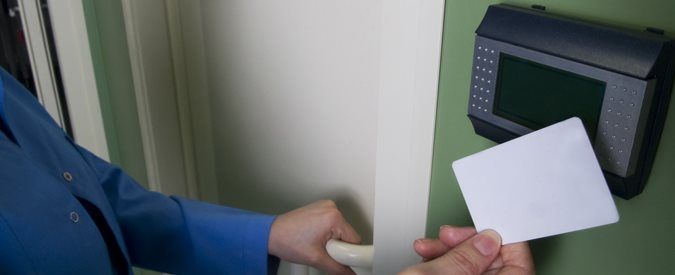Last Updated: April 27, 2023
Compare Biometric vs Card Access Control System Costs
KompareIt.com message: Let us do the work for you. Answer a few short questions & get cost estimates for your needs from trusted access control companies who service your area. Our service is 100% free!
Biometric Access Control Overview
Facial recognition and iris scanning are not the stuff of science fiction anymore. Companies and organizations with a need for high security are using this biometric technology to control access to their buildings.
Biometric access control systems identify physical features to allow employees to enter the front door or restricted areas of the building. In addition to facial recognition and iris scanning, there are fingerprint, hand and retina scanners - even voice recognition devices.
Biometric access systems range in size from very small doorknobs to large pieces of equipment that require a security attendant. The most common (and affordable) form of biometrics is a fingerprint reader.
Biometric Access Control Systems Cost
It’s not uncommon to pay about $10,000 per door or access point for a biometric access system that is fully networked. However, prices vary based on the type of biometric access system you select. Fingerprint scanners can be found for less, while facial recognition systems are priced more than most companies are willing to pay.
Biometric Access Control Systems Pros
- Security - Biometric access is considered the most secure form of access. It’s nearly impossible to duplicate someone else’s fingerprint. Biometric access is widely used by banks, defense contractors, government organizations and other industries with a need for high security.
Compare Access Control Prices
Fill out our 30 second free form to receive competitive pricing from pre-screened access control companies. No commitments. Our service is always free!
Biometric Access Control Systems Cons
- Cost - The added security comes at a price. Biometric access systems are considerably more expensive than card access systems.
- Employee resistance - Some employees may not be comfortable with the idea that their fingerprints or retinas must be scanned in order to gain access the building.

Card Access Control Systems Overview
Card access control systems are quickly growing in popularity as technology improves. They perform all the same functions as traditional wired systems, but offer the convenience of a handheld device.
Card access control systems use handheld computers, PDAs or tablets. As barcodes are scanned or order information is entered, the system wirelessly transmits the information back to a base station. Card access control systems are also capable of processing credit cards.
A wireless access control system can transform the way you do business. Restaurant servers can send orders right from the table. Cashiers can ring up a purchase and print a receipt from anywhere in the store. Warehouse employees can use wireless POS to scan shelves and find out which items need to be restocked. The possibilities are almost endless.
Card Access Control Systems Cost
Card access is by far the most common type of access control system. Employees carry a card or identification badge that they use to gain entry to the front door or restricted areas of the building.
The proximity card is the most common type of access card. The card simply needs to be waived in front of a sensor to unlock the door. You can also opt for magnetic stripe or barcode cards that need to be swiped through a reader, although they tend to wear out faster.
For greater security, opt for cards that are custom-printed to include a photo of each employee. A security guard stationed near the entrance can check the photos for accuracy, making sure employees aren’t sharing access cards. Of course, if you don’t have a security guard, the photos won’t do any good.
Card Access Control Systems Pros
- Cost - Card access systems can be found at a fraction of the price of biometric access systems.
Card Access Control Systems Cons
- Security - Card access systems create an effective layer of security. But they’re certainly not foolproof. Employees can borrow one another’s identification cards. And cards can be lost or stolen, increasing the risk of unauthorized access to the building.
- Replacement costs - It’s inevitable that employees are going to lose their cards from time to time. Keep in mind that you’ll have to pay to replace them. It’s always a good idea to order extra upfront.
Find the Best Access Control Companies Who Will Compete for Your Business
Compare Access Control Prices
Fill out our 30 second free form to receive competitive pricing from pre-screened access control companies. No commitments. Our service is always free!